The Process Spectroscopy Market is expected to register a CAGR of 11.1% from 2025 to 2031, with a market size expanding from US$ XX million in 2024 to US$ XX Million by 2031.
The report is segmented by Type (Portable Type, Benchtop); Techology [Near Infrared (NIR) Spectroscopy, Raman Spectroscopy, Fourier Transform Infrared (FTIR) Spectroscopy, Others]; End Use Industry (Oil and Gas, Pharmaceuticals, Food and Beverages, Metal and Mining, Chemicals, Water and Wastewater, Others); Geography (North America, Europe, Asia-Pacific, Middle East & Africa, South and Central America).
The global analysis is further broken-down at regional level and major countries. The report offers the value in USD for the above analysis and segments
Purpose of the Report
The report Process Spectroscopy Market by The Insight Partners aims to describe the present landscape and future growth, top driving factors, challenges, and opportunities. This will provide insights to various business stakeholders, such as:
- Technology Providers/Manufacturers: To understand the evolving market dynamics and know the potential growth opportunities, enabling them to make informed strategic decisions.
- Investors: To conduct a comprehensive trend analysis regarding the market growth rate, market financial projections, and opportunities that exist across the value chain.
- Regulatory bodies: To regulate policies and police activities in the market with the aim of minimizing abuse, preserving investor trust and confidence, and upholding the integrity and stability of the market.
Process Spectroscopy Market Segmentation
Type
- Portable Type
- Benchtop
Techology
- Near Infrared Spectroscopy
- Raman Spectroscopy
- Fourier Transform Infrared Spectroscopy
- Others
End Use Industry
- Oil and Gas
- Pharmaceuticals
- Food and Beverages
- Metal and Mining
- Chemicals
- Water and Wastewater
- Others
Geography
- North America
- Europe
- Asia-Pacific
- South and Central America
- Middle East and Africa
You will get customization on any report - free of charge - including parts of this report, or country-level analysis, Excel Data pack, as well as avail great offers and discounts for start-ups & universities
Process Spectroscopy Market: Strategic Insights

-
Get Top Key Market Trends of this report.This FREE sample will include data analysis, ranging from market trends to estimates and forecasts.
Process Spectroscopy Market Growth Drivers
- Increasing Demand for Real-Time Analysis: One of the major demands driving the process spectroscopy market includes the need for real-time analysis in manufacturing processes. Some of the key sectors that continuously face the need to produce more efficiently, with less costs, and with product quality are pharmaceutical, chemicals, and food and beverage. Using non-destructive process spectroscopy capabilities makes available real-time monitoring of both chemical compositions and process parameters during various manufacturing processes, allowing users the opportunity to make timely decisions. This is why spectroscopic solutions are increasingly being applied throughout such industrial applications.
- Regulatory Compliance and Quality Control: The process spectroscopy market is further driven by the strict regulatory environment in pharmaceuticals and food safety. The regulatory authorities insist that manufacturers meet quality control standards so that products are safe for use and effective. Techniques in process spectroscopy, including NIR and Raman spectroscopy, ensure compliance through quality testing of the product throughout the cycle of production. The need for quality assurance measures is driving the market forward as companies look to fulfill regulatory requirements in an efficient manner.
Process Spectroscopy Market Future Trends
- Growing Focus on Sustainability and Green Chemistry: The trend towards sustainability and green chemistry is influencing the process spectroscopy market. Industries are increasingly seeking methods to reduce waste, minimize environmental impact, and enhance energy efficiency. Process spectroscopy supports these goals by enabling real-time monitoring of chemical reactions and byproducts, leading to more efficient processes and reduced resource consumption. As sustainability becomes paramount, the market will increasingly demand spectroscopy solutions that can add to more sustainable practices.
- Growth and Innovation in the Process Spectroscopy Market: The process spectroscopy market is expected to expand as industries prioritize real-time, in-line monitoring for improved efficiency and product quality. Advancements in multi-dimensional spectroscopy, AI integration for data analysis, and growing demand from pharmaceuticals, chemicals, and food processing sectors will drive adoption. Sustainability and automation will further accelerate growth.
Process Spectroscopy Market Opportunities
- Integration with Industry 4.0 and Smart Manufacturing: The growth trend of Industry 4.0 and smart manufacturing itself holds great opportunities for process spectroscopy. Integration of spectroscopy solutions with automated systems, IoT, and data analytics is also one of the integration capabilities which will improve process monitoring and control. Manufacturers can thereby leverage the real-time data emanating from spectroscopy instruments and maximize operation, improve predictive maintenance, and reduce downtime with respect to spectroscopy and consider it an integral part of a modern manufacturing ecosystem.
- Development of Multimodal Spectroscopy Solutions: There exists an opportunity to develop multi-modal solutions in spectroscopy that encompass different spectroscopic techniques including NIR, Raman and UV-Vis spectroscopies. In multi-modal systems, complete insights could be gained from material properties and process dynamics. Accuracy and reliability of such processes would be increased with comparison to single-method approaches. This development is likely to attract a greater range of applications and industries, creating further growth opportunities in the market.
Process Spectroscopy Market Regional Insights
The regional trends and factors influencing the Process Spectroscopy Market throughout the forecast period have been thoroughly explained by the analysts at The Insight Partners. This section also discusses Process Spectroscopy Market segments and geography across North America, Europe, Asia Pacific, Middle East and Africa, and South and Central America.
Process Spectroscopy Market Report Scope
| Report Attribute | Details |
|---|---|
| Market size in 2024 | US$ XX million |
| Market Size by 2031 | US$ XX Million |
| Global CAGR (2025 - 2031) | 11.1% |
| Historical Data | 2021-2023 |
| Forecast period | 2025-2031 |
| Segments Covered |
By Type
|
| Regions and Countries Covered |
North America
|
| Market leaders and key company profiles |
|
Process Spectroscopy Market Players Density: Understanding Its Impact on Business Dynamics
The Process Spectroscopy Market is growing rapidly, driven by increasing end-user demand due to factors such as evolving consumer preferences, technological advancements, and greater awareness of the product's benefits. As demand rises, businesses are expanding their offerings, innovating to meet consumer needs, and capitalizing on emerging trends, which further fuels market growth.

- Get the Process Spectroscopy Market top key players overview
Key Selling Points
- Comprehensive Coverage: The report comprehensively covers the analysis of products, services, types, and end users of the Process Spectroscopy Market, providing a holistic landscape.
- Expert Analysis: The report is compiled based on the in-depth understanding of industry experts and analysts.
- Up-to-date Information: The report assures business relevance due to its coverage of recent information and data trends.
- Customization Options: This report can be customized to cater to specific client requirements and suit the business strategies aptly.
The research report on the Process Spectroscopy Market can, therefore, help spearhead the trail of decoding and understanding the industry scenario and growth prospects. Although there can be a few valid concerns, the overall benefits of this report tend to outweigh the disadvantages.
Frequently Asked Questions
What are the options available for the customization of this report?
What are the deliverable formats of the market report?
What are the future trends of the Process Spectroscopy Market?
What are the driving factors impacting the global Process Spectroscopy Market?
What is the expected CAGR of the Process Spectroscopy Market?
- Historical Analysis (2 Years), Base Year, Forecast (7 Years) with CAGR
- PEST and SWOT Analysis
- Market Size Value / Volume - Global, Regional, Country
- Industry and Competitive Landscape
- Excel Dataset
Recent Reports
Testimonials
Reason to Buy
- Informed Decision-Making
- Understanding Market Dynamics
- Competitive Analysis
- Identifying Emerging Markets
- Customer Insights
- Market Forecasts
- Risk Mitigation
- Boosting Operational Efficiency
- Strategic Planning
- Investment Justification
- Tracking Industry Innovations
- Aligning with Regulatory Trends





















 Get Free Sample For
Get Free Sample For